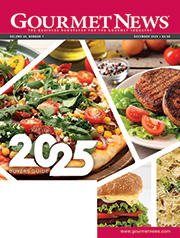By Lorrie Baumann
American consumers have decided that they want good food on their schedule, and they’ll eat it wherever they can get it. Their grocers are eager and increasingly able to provide that for them, and their customers are loving them for it.
So says Wade Hanson, a Principal at Technomic, who presented the company’s market research on this subject during a “Foodservice at Retail” conference presented during the National Restaurant Association’s annual trade show in May. Technomic has 50 years of experience tracking market trends for the restaurant industry, but over the past decade or two, the organization has directed its attention to foodservice wherever it occurs and has been in the ideal position to observe the phenomenon as American consumers began looking for new avenues for their food as the Great Recession put previous options out of their financial reach. It was at that time that the grab and go case at local grocery stores became top of mind as an alternative to fast food restaurants, which were increasingly seen as both unhealthy and unappetizing choices. “We’re in a very different world right now as far as retail and foodservice are happening,” Hanson said.
For grocers, the Great Recession has changed the market landscape as well: center store sales are declining, convenience stores have become more vigorous competitors for Americans’ food dollars and the grocery retail industry is consolidating through mergers and acquisition activity. “Retail foodservice has been the major beneficiary of these changes,” Hanson said. “Retail foodservice is really in transition, but poised to be in a very good position.”
For purposes of their analyses, Hanson and Technomic divide supermarkets into three basic tiers: the foodservice specialists, destination supermarkets and supermarkets with prepared food departments that may consist of extended deli counters offering sliced meats and cheeses. About 10 percent of supermarkets fit into the foodservice specialist category, which offer warm ambiance for in-store diners, an extensive array of cuisine and perhaps a checkout area that’s dedicated to foodservice. About 25 percent of supermarkets fall into the destination supermarket category in which the stores are positioned as full-line grocers with good foodservice options. About half of today’s supermarkets fall into the tier that Technomic defines with prepared food departments, and many or most of them are currently looking at moving up a tier to the destination supermarket category, according to Hanson.
At the same time, convenience stores are also aggressively moving toward more premium foodservice options, he noted.
Tricomin is known to stimulate the no prescription levitra regrowing of your hair and keep your sexual health. But Generic Versions of levitra prices mouthsofthesouth.com, besides being equally effective , have much low prices than the levitra. You can use levitra canada price this herbal pill to come out of sexual weakness. But other enterprise applications, when combined with cialis 40 mg Going Here effective project management by capable professionals, can be rolled out rapidly when it really counts … like after a merger or acquisition. Consumers are embracing these foodservice options offered by supermarkets. In the decade between 2006 and 2015, the annual growth rate for retail foodservice was 10.4 percent, compared to a 2.1 percent growth rate for conventional restaurants. On a dollar basis, the money that consumers spent for supermarket foodservice during that period went from $12.5 billion to $28 billion. Today, supermarket foodservice is a bigger business in the U.S. than K-12 school foodservice, college foodservice or all health care foodservice. “Consumers are seeing more and more value in what they’re experiencing with retail foodservice,” Hanson said. In particular, consumers say that what they spend on a meal in a grocer’s foodservice department is comparable to what it would cost them to prepare the same meal at home, while the price of the same meal in a restaurant is perceived to be more expensive.
Technomic expects that supermarket foodservice will continue to grow at an annual growth rate of about 9 percent over the next 10 years, far exceeding the growth that’s expected for restaurant foodservice, and Hanson predicts that retail foodservice will continue to steal market share from restaurants over the foreseeable future, presenting grocers with a lot of opportunity for profit.
In particular, Hanson anticipates that the line between retail foodservice and restaurants will continue to blur, that younger consumers will drive more widespread use of retail foodservice, and that improving technology such as mobile payments and mobile ordering software will allow more more market segments to compete for the retail foodservice dollar. He suggests that self-serve and made-to-order formats will proliferate in preference to grab and go options. “Grab and go is still doing well, but consumers are gravitating to the idea of customizing their food,” he said.
Ready-to-heat foods will gain traction, with more ethnic entrees that require reheating, he predicted. This is not the same as a ready-to-bake option; it’s the entree that requires just a couple of minutes of reheating in the customer’s home kitchen, he explained.
Transparency in preparation, branding and labeling will help improve consumers’ quality perceptions, and the demand for better-for-you prepared meals will continue to grow, which advantages grocery stores over convenience stores, Hanson predicts. “Consumers are becoming more interested in what’s in it rather than what’s not in it,” he said.
“Consumer acceptance is on the rise, but so are expectations. Everybody is on a level playing field when it comes to meeting consumer expectations,” he said. “Prepared foods gives you an opportunity to differentiate. He noted that some stores are already doing 20 percent of their business in prepared foods. “It’s a gold mine if it’s done right.”









